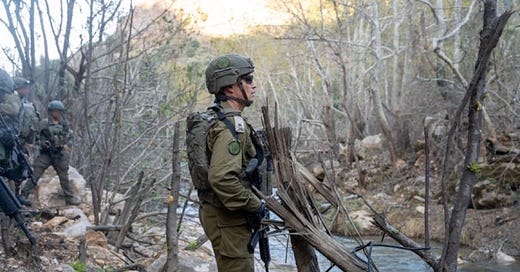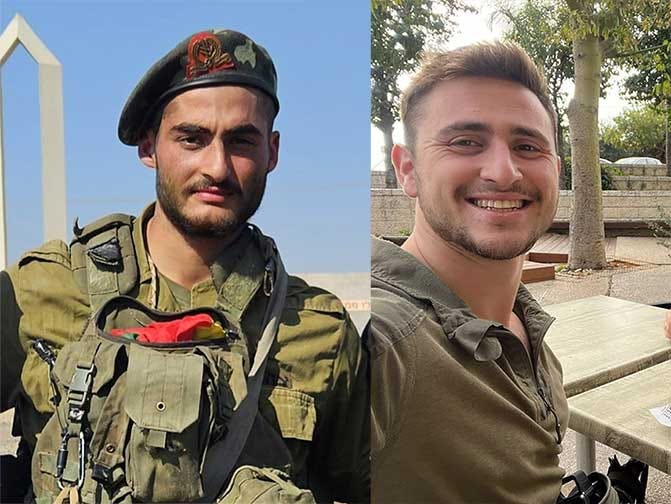DAY 417 OF THE WAR: Biden Announces Hezbollah-Israel Ceasefire To Take Effect Overnight, Residents of the North Angered By Ceasefire’s Terms, Two Soldiers Die
Tel Aviv Diary, November 26, 2024
President Biden has announced that a ceasefire in Lebanon will begin at 4 AM. The announcement followed a statement from Prime Minister Netanyahu regarding the agreement.
Here are the Ceasefire terms:
1. Ceasefire by all parties: Hezbollah and all armed groups will cease all fire on Israel.
2. Israeli actions: Israel will refrain from armed actions against targets in Lebanon’s land, air, and sea.
3. UN Resolution 1701: Both Israel and Lebanon recognize the importance of implementing UN Resolution 1701.
4. Right to self-defense: Both nations reserve the right to self-defense.
5. Exclusive Lebanese Army control: Only the Lebanese Army will be permitted to bear arms in southern Lebanon.
6. Arms control: The production and sale of arms in Lebanon will be regulated by the Lebanese government.
7. Dismantling unauthorized military infrastructure: All military infrastructure not under the control of the Lebanese Army will be dismantled.
8. Enforcement committee: A committee acceptable to both Israel and Lebanon will be established to enforce the agreement.
9. Reporting violations: Both nations will report any violations of the agreement.
10. Lebanese Army deployment: The Lebanese Army will deploy to the south and manage all border crossings.
11. Israeli withdrawal: Israel will withdraw its forces over a 60-day period.
12. US mediation: The United States will work with Israel and Lebanon to resolve any border disputes.
U.S. Commitments in a Side Letter:
The United States and Israel will share intelligence on potential violations,
with the U.S. providing that information to Lebanon.
The U.S. is committed to preventing Iran from gaining more influence in Lebanon.
The U.S. recognizes Israel’s right to take necessary actions in defense of its security.
Netanyahu’s Address
Prime Minister Netanyahu delivered a prerecorded speech to explain the agreement. However, his remarks were brief and lacked detailed explanations. The speech was recorded prior to receiving cabinet approval. In his address, he outlined three primary reasons for entering into the agreement:
1. Iran: Netanyahu implied the agreement redirects focus toward Iran but offered no further elaboration.
2. Military readiness: The ceasefire would allow the Israeli army to recover and replenish weapon supplies, with the U.S. reportedly promising to accelerate arms deliveries.
3. Hezbollah-Hamas separation: The agreement aims to isolate Hezbollah from Hamas.
Netanyahu emphasized the success of Israel’s military operations, but acknowledged public skepticism about the agreement. While some in Israel view the ceasefire as a strategic achievement, public sentiment remains wary and critical.
RESIDENTS OF THE NORTH REACT
Residents of northern Israel are predominantly outraged about the agreement, primarily due to the proximity of Shiite villages along the border—some located as close as 100 meters from their homes. These villages, largely inhabited by Hezbollah members, were expected by residents to be designated as a “no-man’s land” under the agreement, ensuring these terror nests would not be rebuilt. However, this stipulation was omitted from the final deal. Consequently, many in the North are voicing their anger, declaring their refusal to accept this aspect of the agreement.
LEBANON
While Israel braced for a significant Hezbollah bombing attack today, what unfolded instead was one of the largest Israeli offensives on Beirut and other cities in Lebanon. In a brief two-minute span, Israeli airstrikes demolished two buildings in Beirut. It appears that the Israeli Air Force is seizing this opportunity to eliminate all remaining structures on its target list.
Meanwhile, Israeli forces have advanced further into Lebanon than at any point since 2000, crossing the Litani River for the first time
.
The IDF Spokesman issued a statement describing one of the attacks as follows:
The IDF completed strikes on 20 terror targets in Beirut within a swift 120-second operation involving eight fighter jets. The targets included seven Hezbollah financial management and storage sites, such as headquarters, cash depots, and branches of the Al-Qard al-Hassan Association. This association is used by Hezbollah to collect and store funds that support its military buildup. These strikes follow earlier IDF operations against Hezbollah’s financial network
In recent weeks, significantly impacting the organization’s military capabilities. It should be noted that the Israeli Defense Minister recently announced economic sanctions against 24 major depositors in the association, citing their involvement in funding terrorism. Anyone choosing to deposit money with the association risks severe international sanctions.
Additionally, Israeli Air Force fighter jets, guided by Military Intelligence, struck 13 Hezbollah targets in the Dahiya district of Beirut. The targets included an air unit center, intelligence headquarters, command centers, weapons depots, an operations room, an artillery warehouse, and military buildings.
The Strategic Implications of the War
With the war in the North nearing its end, it is time to reflect on what has transpired. Thomas Friedman, who is not known for supporting the current Israeli government, wrote this morning:
In just the last two months, the Israeli military has inflicted a defeat on Iran that approaches its 1967 Six-Day War defeat of Egypt, Syria, and Jordan.
Most Israelis have not fully grasped the magnitude of this achievement. The country is still grappling with too much trauma to see anything positive emerging from this year. Nonetheless, the reality is profound: Iran believed it had a winning strategy by constructing a “ring of fire” around Israel. Hamas, a minor player in this strategy, capitalized on Israeli vulnerabilities to inflict unprecedented damage, surpassing any adversary since the founding of the state. However, the enormous price paid by Hamas and Gaza has been so severe that it’s unlikely others will dare to follow in their footsteps for a long time.
Most notably, Hezbollah, armed with a vast missile arsenal, was prepared to terrorize Israel. Their rockets were expected to bring down skyscrapers in Tel Aviv, hit power plants, and leave Israel without electricity for weeks. This is without mentioning Hezbollah’s plans for a surprise ground invasion to occupy northern Israel, via their massive network of cement-lined terror tunnels.
These were real concerns that many Israelis prepared for—some by buying generators, and in our case, a large battery to power essential devices like laptops. Thankfully, those precautions proved unnecessary. Whether it was due to Israel’s “beeper” operation, our advanced warning systems, or outstanding intelligence that enabled the Air Force to neutralize most of Hezbollah's missiles, we found ourselves retreating to our bomb shelter only a handful of times. Our experience mirrored that of millions of Israelis living in the Tel Aviv and Jerusalem Metropolitan areas. For those who live in the North, the experience was markedly different. Many towns along the border suffered heavy damage, and Hezbollah attacks resulted in the loss of 45 civilian lives.
The Hezbollah threat was Iran’s primary leverage over Israel, their deterrent against an Israeli strike on Iran’s nuclear program. Now, after two failed Iranian attacks and two months of full-scale war with Hezbollah, it’s clear that Iran and its proxies have been defanged—if they ever truly posed a serious threat to Israel. Before this campaign, which began almost accidentally due to the deployment of the secret weapon, the “detonating beepers,” I had deep concerns about our physical safety. Thankfully, those fears have now dissipated.
Yona Betzalel Brief and Tamer Othman
Today, we mourn the loss of two more soldiers. The first, Sergeant First Class Yona Betzalel Brief (23), from Maccabim Reut. Critically wounded on October 7th, the first day of the war. Brief had been in intensive care ever since. Today, Brief’s body succumbed to his injuries. The second, Sergeant Tamer Othman (21), from Kfar Yasif, fell during combat in Beit Lahiya, close to Jabalya in northern Gaza.
LATEST PUBLIC OPINION POLLS
Here are some interesting poll results:
BUSINESS
Shufersal
Shufersal’s aggressive cost-cutting measures under the leadership of its new owners, brothers Yossi and Shlomi Amir, have delivered outstanding results. According to its third-quarter 2024 financial report, Shufersal achieved a remarkable net profit of 237 million shekels, representing an impressive 374% increase compared to the same period last year. For the first nine months of 2024, the company’s net profit more than doubled to 496 million shekels, marking a 175% year-to-date growth. This strong performance is attributed to enhanced gross profit margins and a notable improvement in operating profit driven by disciplined expense management
.
Revenue for the quarter grew by 6.3%, reaching 4.1 billion shekels, with same-store sales increasing by 6.5%. Gross profit margin rose to 28.5%, up from 26.2% in the same quarter last year, reflecting Shufersal’s success in boosting revenues while optimizing costs. Operating profit surged to 330 million shekels, more than doubling from 139 million shekels in the third quarter of 2023.
However, Shufersal reported a slight decline in the share of online sales, which accounted for 17.1% of total store and distribution center revenue, compared to 17.9% in the previous year. This shift is attributed to overall network sales growing at a faster pace than online sales.
Pyramid Analytics
Pyramid Analytics, founded in 2009 by CEO Omri Kohl, CTO Avi Perez, and Herbert Hochman, has developed a business data analytics platform and has raised $50 million in funding from financial giant BlackRock, which invested through several of its funds and entities. This brings Pyramid Analytics’s total funding to $250 million.
The company employs over 200 people across Israel, the United States, the United Kingdom, the Netherlands, the UAE, and Germany. Alongside BlackRock, other investors include HIG Growth Partners, which manages over $48 billion in assets, Clal Insurance, Kingfisher Capital, General Oriental, JVP, Maor Capital, Sequoia Capital, and Viola Growth. Pyramid Analytics’ client portfolio includes prominent names such as Kellogg’s, Hallmark, and Deloitte.
Capitolis
The fintech company Capitolis has raised $20 million from four global banks in a funding round led by Citibank. Other participants include State Street, an existing investor, as well as new investors Morgan Stanley and UBS. Each bank will contribute $5 million. In its previous funding round, Capitolis was valued at $1.6 billion, though the current valuation has not been disclosed. To date, the company has raised a total of $300 million.
Capitolis employs 130 people in Israel and New York and has developed a platform aimed at creating safer and more dynamic financial markets by optimizing and expanding access to capital sources. The company’s system serves as a vital “oxygen supply” for the global banking system, enabling banks to increase their activity while reducing risks.
Capitolis is backed by prominent investors, including Canapi Ventures, 9Yards Capital, SVB Capital, Andreessen Horowitz (a16z), Index Ventures, Sequoia Capital, Spark Capital, and S Capital, alongside leading global banks such as Citibank, J.P. Morgan, Morgan Stanley, State Street, and UBS.
The company was founded in 2017 by Gil Mandelzis, Tom Glocer, and Igor Telyatnikov. Mandelzis is the former founder of fintech company Traiana, which was acquired by British firm ICAP in 2007 for approximately $250 million. Glocer previously served as the CEO of Thomson Reuters.
∞–––––∞–––––∞–––––∞–––––∞–––––∞–––––∞–––––∞–––––∞–––––∞
A PIECE OF HISTORY
How the 2014 Gaza War Began; The Path to Conflict— Part 2
The 2014 Israel-Hamas war, also known as “Operation Protective Edge,” was a 50-day conflict marked by intense fighting, significant casualties, and widespread destruction. The war began on July 8, 2014, when Israel responded to increased rocket fire from Gaza. The situation rapidly escalated into a full-scale military operation involving airstrikes, a ground invasion, and unprecedented rocket attacks targeting Israeli cities, including Tel Aviv, which had previously been spared such assaults. The Iron Dome missile defense system intercepted hundreds of rockets, but the constant alarms and explosions disrupted daily life, leaving a lasting psychological impact on the population.
A central feature of the conflict was Hamas's use of a sophisticated tunnel network, which they employed to smuggle weapons, infiltrate Israel, and launch surprise attacks. On July 17th, 13 Hamas militants infiltrated Israel near Kibbutz Sufa via a tunnel, but the IDF intercepted and neutralized the group before they could carry out a massacre. The subsequent discovery of 32 such tunnels underscored the scale of the threat and prompted Israel to prioritize their destruction during its ground offensive. The tunnels symbolized a new and unsettling dimension of the conflict, complicating efforts to achieve security.
The ground offensive, which began on July 17, 2014, was one of the most intense phases of the war. Fierce fighting occurred in Gaza neighborhoods like Shuja'iyya, where, on July 20th, 13 Israeli soldiers were killed, including seven in an armored personnel carrier (APC) hit by an anti-tank missile. Hamas also captured the body of Sgt. Oron Shaul during the battle, sparking national and military outrage in Israel. On July 28th, five more soldiers were killed in an attack on an IDF base near Nahal Oz, further highlighting the deadly toll on both sides.
The war resulted in significant casualties: 70 Israelis, including 64 soldiers, lost their lives, while more than 2,100 Palestinians were killed, many of them civilians, according to Gaza health officials. Thousands more were wounded, and widespread destruction left large parts of Gaza in ruins. The IDF struck over 5,200 targets in Gaza, including rocket launch sites, weapon factories, and militant homes, while Hamas launched more than 3,600 rockets and mortars at Israel. The disparity in casualties and destruction fueled international criticism of Israel, even as the nation argued it was defending itself against relentless attacks.
Humanitarian pauses and ceasefires punctuated the conflict, but many were short-lived as Hamas or other groups violated the agreements with renewed rocket fire. On August 26, an Egyptian-brokered ceasefire finally ended the war. The agreement was nearly identical to one that Hamas had rejected at the start of the conflict, leading many to question the gains achieved by either side. Hamas declared victory, but its infrastructure was severely weakened, while Israel’s Iron Dome and military strategies were both validated and criticized for their execution.
The 2014 war left deep scars on Israeli and Palestinian societies. It highlighted the growing sophistication of Hamas's tactics and the vulnerabilities of both populations. The psychological and physical tolls of the conflict underscored the challenges of achieving lasting peace in a region marked by cycles of violence and enduring grievances.
This week’s radio show











Marc, what do you think of the treaty failing to move the nearby Shiite villages? Was that a big miss or something that can be protected by the IDF?